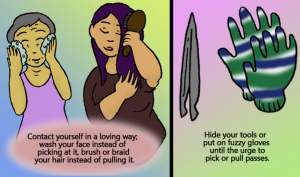It’s seven in the morning, and you’ve just woken up.
Right away, you can tell something’s wrong. You feel woozy – and the skin around your stitches is red and swollen.
You pause for a minute to think about whether you can afford to take the time off work to get to the doctor.
You decide you have to. Unfortunately, you don’t have a primary care doctor because you only moved to the city a few months ago, so you spend an hour online trying to figure out which doctors your insurance covers.
Once you’ve gotten a list of doctors, you try looking them up.
You have to know if they’ll be able to care for you – not only do you not want to be treated like crap because you’re trans, but also, the reason for your visit is complications from top surgery.
You need to know they know how to take care of people like you.
Frustratingly, you can’t find any information about the doctors’ LGBTQIA+ record, so you’re forced to pick at random.
When you get to the doctor’s office, the receptionist calls you “ma’am,” and you’re too tired to correct him.
You slump down in your chair, defeated, and fill out a form that seems to assume certain things about you, like that you’ve memorized your immunization history, or that you know where your birth mother was born.
You look around the office and notice flyers advertising free wellness classes.
The picture of the skinny white woman doing yoga on the flyer convinces you that you’re not the right type of person for the classes.
You sigh – disappointed, yet unsurprised.
What’s Wrong With This Picture?
Before you’ve even seen a medical professional, you’ve had a series of experiences with the healthcare industry.
You’ve had to consider the cost of taking off work to get healthcare. You’ve had to navigate the confusing insurance requirements for finding a doctor you can afford.
You’ve had to think about whether the doctor will treat you poorly, or even know how to care for you at all. You’ve had an untrained healthcare professional mis-gender you, been unable to fill out a simple form completely because of the nature of the questions, and been turned off from the idea of pursuing wellness opportunities because the advertising was clearly not directed at you.
In every one of these scenarios, intentional practices and language could have helped.
Your insurance could have made finding a new provider simpler and easy to do online. The doctors could have displayed their strengths and areas of focus. The office personnel could have attended training on how to create a welcoming environment for patients. The wellness classes could have featured people who look like you, language that made you feel comfortable.
I know this all too well.
I’m a community health worker for a living – and one of my duties is to help host a quarterly meeting to get all the regional coordinators in my state together to talk about how to get our programs to more people, keep people engaged, and achieve the best outcomes for the people we serve.
Sometimes these meetings are boring info sessions about marketing strategies and panel management (feel free to ask me what this is in the comments if you’re curious – but it’s nerdy public health stuff, so be warned!).
But sometimes, like this time, we get into the nitty-gritty of what we can do as healthcare educators to keep people in our programs and help them get the most out of them.
The Words We Use Have A Resounding Impact
Language use in healthcare – like language use everywhere – is a huge issue in regards to accessibility.
In fact, “[l]ow health literacy, cultural barriers, and limited English proficiency have been coined the ‘triple threat’ to effective health communication” according to the Online Journal of Issues in Nursing.
And if we want to effectively extend care to everyone (which we should), we have to address these obstacles.
Although there’s only so much we can do about non-English speakers (I speak as a community health worker with no power to hire translators, although the budget considerations for hospitals are a different issue), there are an incredibly large number of interventions we can put in place to help people with low health literacy and/or cultural barriers to accessing healthcare enroll in and succeed in our programs.
Our goal as health workers, in offering self-management programs for chronic conditions, is to improve public health and to cut down on healthcare costs by offering preventative care.
This cannot be accomplished without making sure that everyone has access to these programs, regardless of their level of health literacy.
Transportation scholarships and translators are things that I, as a healthcare professional, try to get into budgets, but inclusive and affirming language is something that anyone, no matter how involved in the healthcare industry they are, can implement to serve health-seekers better.
To my delight, at the healthcare coordinators’ meeting, we had a conversation about how language affects access to programs, managing to inject some feminism into a field that largely doesn’t engage with social justice practices.
Language is shaped by culture, age, environment, education, personal biases, location, experiences, identity, and a variety of other factors. It’s not static – and it’s tightly connected to how you see the world.
From the recruitment materials (which need to use language that doesn’t turn people off) to the group values (which need to mean the same thing to every participant), language used by self-management facilitators has to be clear, positive, and – most importantly – widely understood with an agreed-upon definition.
So here are a few areas where attention to language can make self-management programs stronger:
1. Advertising and Recruitment
When you think about advertising, do you mention illness? Are you labeling? Are you giving out a picture of helplessness and disability? Are you “robbing people of their hope?” Are you relying on stereotypes that alienate and harm the people you are trying to reach?
Workshops that are too illness-oriented may encourage people to think of themselves as their diagnosis, which sometimes makes it difficult to believe that change is possible.
A colleague at the meeting discussed her decision to change the language in her Livestrong (a group for people with or recovering from cancer) from “survivor,” which is not a label everyone wants to apply to themselves, to “growing stronger together,” which covers both the people who want to think of themselves as survivors and the people who want to move on from that aspect of their life.
In social-justice circles, we do this all the time. Words and phrases like “non-binary,” “of color,” and “undocumented” evolved to describe communities and their members respectfully and accurately—it’s about time this phenomenon made it into the health care system!
In addition, our programs can seem very specific-disease-focused, but many of them can be expanded to fit the needs of many different types of people with chronic conditions, as well as people simply looking to improve their health.
Changing the program language will make participation more attractive to people who may not feel like “a person with diabetes” or “a mentally ill person,” but who can still benefit from the programs.
2. Participation and Trust within the Group
One facilitator explained that she’ll stop a class to explain a word – or acknowledge that the group needs to agree on a definition. Words like respect, confidentiality, and success can trip people up.
If you stop and agree on a definition, it gives people with less cultural privilege more power because they contributed to defining the word in a way that works for them.
3. Sensitivity to Marginalized Groups
People in poverty have different needs, and different populations may be either limited in the choices they have (by finances, being incarcerated, and so on) or never having been introduced to the concept of self-management as a positive thing.
Language use is particularly important in this context. It needs to be engaging, non-intimidating, and logical.
Meeting people where they are is also essential.
Even a frank conversation about what support someone might get from, say, a group of heroin addicts, can be detrimental if you are too aggressive. Be prepared for people to say that they really do have support from people who seem like poor supports to you, and be prepared to accept and support their decisions.
The tone of your questions makes a difference in how successful you’ll be in offering different ideas for their wellness.
Thinking of yourself as a peer, bearing in mind (and sometimes even telling!) your own personal stories can help you empathize and build a connection.
4. Health Outcomes for the Participant
It’s important not to discourage people from exploring their options.
It’s tempting to paint your program as the best in the land, but in reality, the more resources people have to improve their health, the better!
Focus on the person needing healthcare – more options is nearly always better.
Remember that once you’ve engaged someone, you need to have things to offer them, such as a follow-up class once theirs ends, or you’re going to lose momentum.
Language also needs to be carefully crafted not to stifle people’s efforts to self-advocate.
People can start out very aggressive when taking charge of their health, but if we remain calm and not defensive, we can learn a lot about what works best for them.
We also need to be careful not to, accidentally or otherwise, separate people from their natural supporters just because we don’t believe them to be the best kind of support.
More support and less judgment is always the best way to build trust.
5. Keeping Yourself in Check
Attend trainings. Accept feedback graciously. Keep up with trends in social justice language use.
But most importantly, listen to your participants.
Body language, level of engagement, and literacy levels are some ways that you’ll know that the way you’re talking needs to change. Paying attention to signs of ability, interest, comprehension, and emotional buy-in is a good way to tell if you need to change your approach.
Self-management programs are life-savers for many chronically ill people, but they work best when the people delivering the programs are flexible and keep the best interests of the participants in mind.
***
Although these suggestions came from a discussion between mainly hospital administrators and nurses, this kind of intentional language use is widely useful.
As a community health worker, I use inclusive language in my interactions with the public –both in an official capacity as a diabetes prevention program educator and in my dual role as a YMCA employee, but these best practices can be used by anyone even tangentially related to healthcare.
Work at a food bank? These suggestions can help make your interactions with the people you serve more comfortable. Work at a fitness center? These recruitment ideas may help you extend fitness access to more people.
Community workers have the potential to do so much good as people “on the ground”—everyone has a body, and most people access health care at some point in their lives, so we are poised to serve one of the most variable populations of any field.
If we use inclusive language and practices, we can drastically improve public health by increasing the number of people who seek health care, and making sure they come back!
We don’t often think of health care as a field that requires good customer service, but in reality that is what we need to provide if we want people to take care of themselves. Inclusive language is free, it’s kind, it’s respectful, and it’s a powerful tool for creating a healthcare industry that’s truly welcoming.
[do_widget id=’text-101′]
Wiley Reading is a Contributing Writer at Everyday Feminism. Wiley is a New Jersey-born artist, writer, environmentalist, and social justice advocate located in Burlington, VT. He works as a community health worker for the Greater Burlington YMCA, and writes for Disrupting Dinner Parties, a small collective feminist blog. Follow him on Twitter @wreadinggo.
Search our 3000+ articles!
Read our articles about:
Our online racial justice training
Used by hundreds of universities, non-profits, and businesses.
Click to learn more
Most Read Articles
- « Previous
- 1
- …
- 30
- 31
- 32




















